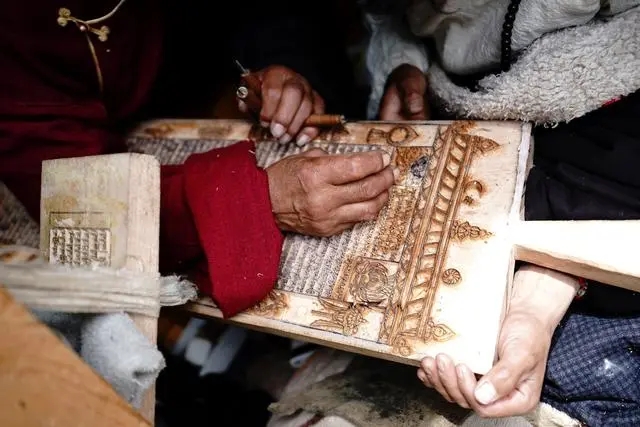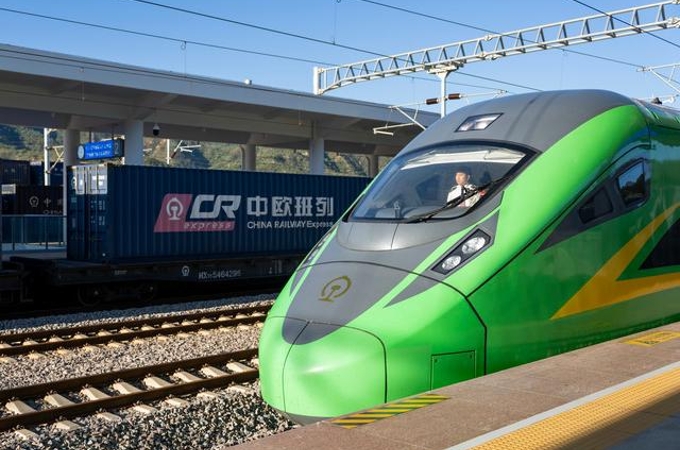Inheriting cultural heritage revitalizes rural lives in Tibet
Source: Xinhua | 2022-10-12 | Editor:Ines

A swishing sound traveled through the sun-bathed village as another busy day kicked off at a woodcarving workshop in Bolo township of Qamdo city, Southwest China's Tibet autonomous region.
The Bolo woodcarving skill, a national intangible cultural heritage, dates back to the Qing Dynasty (1644-1911) and was initially invented to print Buddhist sutras.
According to local craftsmen, the traditional skill was once in danger of being lost, as old artisans found it hard to earn money with their work, and young people were reluctant to learn it.
Things began to change in 2019 when the village officials decided to develop the woodcarving-related industry. An ethnic handicraft company was soon established, including a woodcarving workshop covering 1,400 square meters.
Padma Gyatsen, a local villager, has never been to school. In the past, the only thing he could do for a living was farming and herding. Now, by working in the workshop, he earns more than 4,000 yuan (about $563.44) a month.
"With my wages, I can buy whatever I want and save more than 20,000 yuan a year," he said.
Creating a Bolo wood plate takes more than 10 procedures with over 40 tools. Today, the exquisite artworks are widely used for interior decorations in local homes.
Over the years, the number of craftsmen in the workshop has increased from four to 112. From January to August, local villagers received 1.8 million yuan as dividends from the company, and the total dividends they received added up to 7.85 million yuan.
According to the regional department of culture, a total of 121 intangible cultural heritage workshops have been established in Tibet, creating jobs for 3,053 people from 2,271 households and increasing monthly incomes by more than 3,200 yuan on average.
In an ethnic handicraft industrial park in Chagyab county, artisans at a workshop are engaged in processing Maidoi goldware and silverware, a craft included in the intangible cultural heritage list of Tibet.
"Thanks to the workshop, we can sit together and discuss challenges we are facing, and pool wisdom to attract young artisans and consumers with our products," said Tengpa Doje, an inheritor of the craft.
The handicraft industrial park was established in October 2018 with a total investment of about 27.2 million yuan. It features Tibetan cultural handicrafts such as thangka painting, and goldware and silverware processing, which have helped boost the income of local residents.
By the end of 2021, the industrial park has brought more than 9.6 million yuan to over 670 people in wages or dividends.
"The traditional culture is our treasure. Developing cultural industry enables our culture to be better inherited and protected," said Ren Jianli, an official of Chagyab County.
You May Like
-
China Focus: Beijing Central Axis to compete for world cultu...
Chinese authorities have planned to recommend the Beijing Central Axis as China's 2024 world cultural heritage application project, according to the National Cu...
InKunming 2022-08-10 -
Intangible cultural heritage exhibition held in Xinjiang
An intangible cultural heritage exhibition opened Sunday in northwest China's Xinjiang Uygur Autonomous Region.
InKunming 2022-08-01 -
China tops the world in globally important agricultural heri...
China ranks first in the world in the number of Globally Important Agricultural Heritage Systems (GIAHS) designated by the Food and Agriculture Organization o...
InKunming 2022-05-25 -
Chinese craftsmen revive century-old British heritage buildi...
A three-floor western building covered by traditional Chinese roof ridges glimmers on the south bank of Yangtze River in southwest China's Chongqing Municipalit...
InKunming 2022-04-18 -
Where heritage takes root
China is home to 56 UNESCO World Heritage sites. To find out how these natural and cultural gems still shine and continue to inspire the nation in this new era ...
InKunming 2022-03-31 -
Xilankapu, the intangible cultural heritage
"Xilankapu" is a kind of Tujia brocade, also known as "knitting Floral Bedclothes," was listed as national intangible cultural heritage in 2006.
InKunming 2022-03-24 -
Tengchong: when intangible cultural heritage meets cultural ...
Project that integrates intangible cultural heritage and tourism is blooming in Tengchong. All kinds of intangible cultural heritage culture has become part of ...
InKunming 2021-11-19 -
New initiative launched to preserve cultural heritage in Asi...
The representatives, including government officials, scholars, diplomats, and conservators, participated in the Asian Dialogue for Cultural Heritage Conservatio...
InKunming 2021-11-09 -
Azheke plan motivates heritage folks to value Hani tradition
By carving in hospitable mountains’ slopes into the small patios of arable land, the Hani people have created the marvelous traditional agriculture featuring t...
InKunming 2021-07-16 -
Villagers enriched by heritage tours
The scenic Mt. Laojun in Lijiang is part of the Three Parallel Rivers heritage site in northwest Yunnan. Huang Wenwu, Party chief of Liming village near Laojun,...
InKunming 2021-07-16







